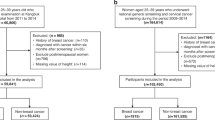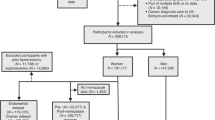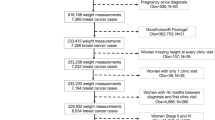Abstract
The relationship of breast cancer to early reproductive development and height suggests that fetal and childhood nutrition may be important in its aetiology. Caloric restriction sufficient to reduce adult height may reduce breast cancer risk. During World War II (WWII) there was a marked reduction in average caloric intake in Norway that resulted in greater nutritional diversity. We hypothesized that a positive association between height and risk of breast cancer would be stronger among women who were born during this period than among women born before or after the war. A total of 25 204 Norwegian women were followed up for approximately 11 years, and 215 incident cases of breast cancer were registered. We found the strongest positive association between height and breast cancer among women born during WWII: women in the tallest tertile (>167 cm) had a relative risk of 2.5 (95% confidence interval = 1.2–5.5) compared with the shortest (≤ 162 cm). Among women born before or after the war we found no clear association with height. The association with height in the WWII cohort may imply a role for early nutrition in breast cancer aetiology. © 2001 Cancer Research Campaign http://www.bjcancer.com
Similar content being viewed by others
Article PDF
Change history
16 November 2011
This paper was modified 12 months after initial publication to switch to Creative Commons licence terms, as noted at publication
References
Brundtland GH, Liestol K and Walloe L (1980) Height, weight and menarcheal age of Oslo schoolchildren during the last 60 years. Ann Hum Biol 7: 307–322
Cacciari E, Salardi S, David C, Tassinari D, Dalla CC, Pilu GL, Mainetti B, Gualandi S and Bovicelli L (2000) Is statural growth predictable in utero? Follow-up from the second trimester of gestation to the 8th year of life. J Pediatr Endocrinol Metab 13: 381–386
Cancer Registry of Norway (1998) Cancer in Norway 1995. Cancer Registry of Norway: Oslo
de Waard F (1975) Breast cancer incidence and nutritional status with particular – to body weight and height. Cancer Res 35: 3351–3356
Ekbom A, Hsieh CC, Lipworth L, Adami HQ and Trichopoulos D (1997) Intrauterine environment and breast cancer risk in women: a population-based study. J Natl Cancer Inst 89: 71–76
Ekbom A, Trichopoulos D, Adami HO, Hsieh CC and Lan SJ (1992) Evidence of prenatal influences on breast cancer risk. Lancet 340: 1015–1018
Galtung-Hansen O (1947) Food conditions in Norway during the war 1939–1945. Proc Nutr Soc 5: 263
Godfrey K, Robinson S, Barker DJ, Osmond C and Cox V (1996) Maternal nutrition in early and late pregnancy in relation to placental and fetal growth. BMJ 312: 410–414
Hankinson SE, Willett WC, Colditz GA, Hunter DJ, Michaud DS, Deroo B, Rosner B, Speizer FE and Pollak M (1998) Circulating concentrations of insulin-like growth factor-I and risk of breast cancer. Lancet 351: 1393–1396
Holmen J and Midthjell K (1990). The North-Trøndelag health survey 1984–86: purpose, background and methods: participation, non-participation and frequency distributions. Statens institutt for folkehelse: Oslo
Juul A, Bang P, Hertel NT, Main K, Dalgaard P, Jorgensen K, Muller J, Hall K and Skakkebaek NE (1994) Serum insulin-like growth factor-I in 1030 healthy children, adolescents, and adults: relation to age, sex, stage of puberty, testicular size, and body mass index. J Clin Endocrinol Metab 78: 744–752
Kaijser M, Lichtenstein P, Granath F, Erlandsson G, Cnattingius S and Ekbom A (2001) In utero exposures and breast cancer: a study of opposite-sexed twins. J Natl Cancer Inst 93: 60–62
Karlberg J and Luo ZC (2000) Foetal size to final height. Acta Paediatr 89: 632–636
Kelsey JL, Gammon MD and John EM (1993) Reproductive factors and breast cancer. Epidemiol Rev 15: 36–47
Kleinbaum DG (1995) Survival analysis: a self-learning text. Springer-Verlag: New York
Le Marchand L, Kolonel LN, Myers BC and Mi MP (1988) Birth characteristics of premenopausal women with breast cancer. Br J Cancer 57: 437–439
Luo ZC, Low LC and Karlberg J (2000) Fetal size to final height in Hong Kong Chinese children. J Pediatr Endocrinol Metab 13: 269–279
MacMahon B (1975) Formal discussion of breast cancer incidence and nutritional status with particular – to body weight and height. Cancer Res 35: 3357
Michels KB, Trichopoulos D, Robins JM, Rosner BA, Manson JE, Hunter DJ, Colditz GA, Hankinson SE, Speizer FE and Willett WC (1996) Birthweight as a risk factor for breast cancer. Lancet 348: 1542–1546
Rona RJ and Chinn S (1995) Genetic and environmental influences on growth. J Med Screen 2: 133–139
Sanderson M, Williams MA, Daling JR, Holt VL, Malone KE, Self SG and Moore DE (1998) Maternal factors and breast cancer risk among young women. Paediatr Perinat Epidemiol 12: 397–407
Sanderson M, Williams MA, Malone KE, Stanford JL, Emanuel I, White E and Daling JR (1996) Perinatal factors and risk of breast cancer. Epidemiology 7: 34–37
Smith GD, Gunnell D and Holly J (2000) Cancer and insulin- like growth factor-I. A potential mechanism linking the environment with cancer risk. BMJ 321: 847–848
Stavola BL, Hardy R, Kuh D, Silva IS, Wadsworth M and Swerdlow AJ (2000) Birthweight, childhood growth and risk of breast cancer in a British cohort. Br J Cancer 83: 964–968
Strøm A (1948) Examination into the diet of Norwegian families during the war-years 1942–1945. Acta Med Scand 214,
Thame M, Wilks RJ, McFarlane-Anderson N, Bennett FI and Forrester TE (1997) Relationship between maternal nutritional status and infant's weight and body proportions at birth. Eur J Clin Nutr 51: 134–138
Toniolo P, Bruning PF, Akhmedkhanov A, Bonfrer JM, Koenig KL, Lukanova A, Shore RE and Zeleniuch-Jacquotte A (2000) Serum insulin-like growth factor-I and breast cancer. Int J Cancer 88: 828–832
Tretli S (1989) Height and weight in relation to breast cancer morbidity and mortality. A prospective study of 570,000 women in Norway. Int J Cancer 44: 23–30
Tretli S and Gaard M (1996) Lifestyle changes during adolescence and risk of breast cancer: an ecologic study of the effect of World War II in Norway. Cancer Causes Control 7: 507–512
Vatten LJ and Kvinnsland S (1990) Body height and risk of breast cancer. A prospective study of 23,831 Norwegian women. Br J Cancer 61: 881–885
Willett W (1998) Nutritional epidemiology. Oxford University Press: New York
Author information
Authors and Affiliations
Rights and permissions
From twelve months after its original publication, this work is licensed under the Creative Commons Attribution-NonCommercial-Share Alike 3.0 Unported License. To view a copy of this license, visit http://creativecommons.org/licenses/by-nc-sa/3.0/
About this article
Cite this article
Nilsen, T., Vatten, L. Adult height and risk of breast cancer: a possible effect of early nutrition. Br J Cancer 85, 959–961 (2001). https://doi.org/10.1054/bjoc.2001.1946
Received:
Revised:
Accepted:
Published:
Issue date:
DOI: https://doi.org/10.1054/bjoc.2001.1946
Keywords
This article is cited by
-
Breast cancer incidence in food- vs non-food-producing areas in Norway: possible beneficial effects of World War II
British Journal of Cancer (2002)



